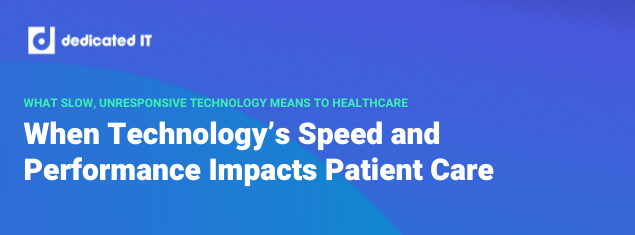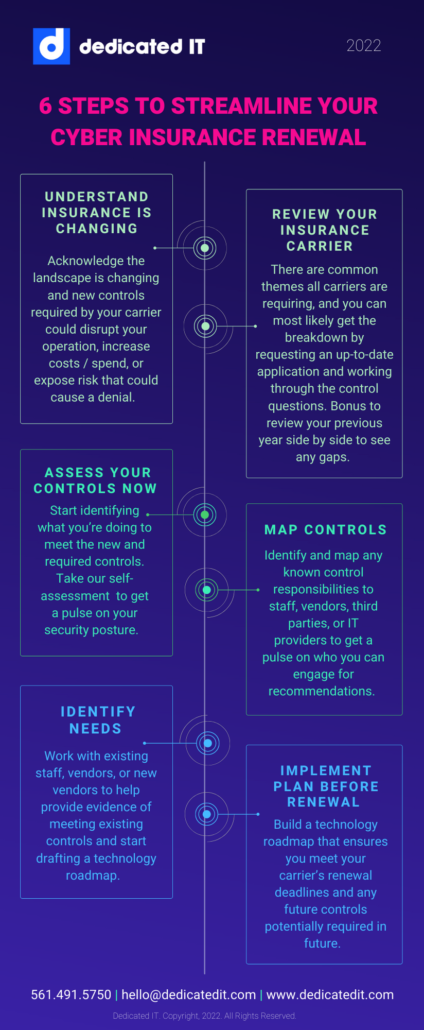Click here to add your own text
When Technology’s Speed and Performance Impacts Patient Care
How Can IT Solve Speed and Performance Issues?
We’ve all been there – that frustrating moment of waiting for your keyboard to catch up with your typing, watching an application load at a snail’s pace, or patiently sitting at your desk waiting for the Internet to come back on. What’s the root cause of technology being slow to respond? How can you identify and fix speed and performance issues?
Let’s take a look at the healthcare sector and how the speed and performance of technology can delay patient care or impact the bottom line.
When Speed and Performance Become a Company-Wide Pain Point
Your organization experiences a decline in speed and performance any time a device, application, browser, or network is unresponsive or slow to respond. It’s an IT pain point that can be pretty specific based on what an organization does, but common scenarios are:
- Computers take a long time to boot into OS
- Applications or browsers take a long time to load
- Computers are slow to respond to clicking, typing, or touching
- Device reset or shutdown takes a while
- Internet constantly goes out
When an employee or a customer becomes annoyed or due to slow or unresponsive technology or it’s impacting the bottom line in some way, IT is typically the first to hear about it and is tasked with finding a solution.
Speed and performance issues in technology is about as frustrating as sitting in traffic. You know you’re stuck, but you don’t know why. If you want to do something about it, you need to understand what the source of the traffic is. It is construction or an accident? Typical rush hour or congestion from a concert?
What Slow and Unresponsive Technology Means to Healthcare
The speed and performance of technology is essential to healthcare practices, for both employees and patients. When a workstation is running slowly, that might prevent a nurse from clocking out on time or moving onto new tasks. When scheduling tools are unresponsive, patients experience long wait times when they can’t afford to sit on hold.
Think about the vast amount of technology required for any type of healthcare practice. There are patient portals, EMRs, telehealth software, imaging, communication or collaboration tools, and even something as simple as the Internet. Technology speed and performance is critical in healthcare because so much depends on it, from everyday tasks to live-saving procedures.
How to Improve Speed and Performance
We believe in a two-part approach to solving speed and performance issues.
First, you have to understand what is slow. Is it slow to respond, or completely useless? Is it the machine or the Internet? Is it the software or the device? Is it happening at one workstation or all of them? This may seem like a basic concept, but you can’t fix speed and performance issues without knowing the cause. A technologist must be able to listen to someone explain their speed and performance complaint and discern the real problem, not the perceived problem. Walking into a situation with a “fix-it” mindset might not solve the root cause, which is most important.
Second, you have to get real: it is a technology problem or a people problem? A technology problem are things like bugs, updates, or replacements. There’s nothing that the user is wrong, it’s literally a technical issue that needs a fix. People problems are more common than you might think. A people problem might look like a lack of training or adoption – we’ve all had coworkers who don’t take IT training seriously or refuse to implement new processes. Or maybe technology just isn’t functioning as the user expected it to, but their expectations were misaligned to begin with.
Say, for instance, an employee reports that they’re experiencing a slow EMR. They might ask your IT department or managed service provider if this is normal, especially in comparison to other users of this EMR. It’s the technologist’s job to figure out what is slow – the EMR? Or the network that the EMR is running on? Could it be a cloud issue? What about the machine the EMR is running on? Is the user using the EMR correctly?
This two-part approach will solve IT tickets efficiently and effectively. If your technologists cannot determine what is causing speed and performance to decline and whether it’s a technology problem or a people problem, you might not have the right type of technologists on staff. They need to know your staff, understand how your staff uses technology, and honor the importance of IT speed and performance.
At the end of the day, your practice is trying to deliver quality, efficient patient care and if you have problems with the speed and performance of your system and processes, you won’t be able to do that. That’s where Dedicated IT can help. With our suite of IT services, robust healthcare-specific knowledge and our two-step approach, we can take the frustration out of speed and performance issues at your practice, allowing you to shift your focus on providing excellent patient care. Don’t wait until your next outage. Contact us today to get started.
5 Reasons You’re Seeing Changes in Cyber Insurance
Why Insurers are Shifting the Industry
Cyber insurance protects organizations from the financial and operational impact of cyber attacks – but not from the attack itself. Getting approved for the appropriate amount of cyber insurance coverage is crucial to risk management, but over the last three years, insurers and underwriters have changed their approach to accommodate the rising claims from ransomware, social engineering, hacking, or email compromise. Over 50% of insurance brokers’ clients saw prices go up 10–30% in 2020, then another 30-40% in 2021. What’s the cause of these changes?
1. Industry Costs are Rising
In the past, cyber insurance was a soft market characterized by high capacity and low premiums. The world we live in today has changed that. Systems, processes, and workflow changes have increased costs for insurers – but the threats have evolved too. The costs associated with recovering from a cyberattack have skyrocketed in the last few years, going from $760,000 to $1.85 million. The entire cyber insurance industry has hardened as insurers see their payouts rising faster than the income from premiums. Changes have to be made to account for rising costs and threats.
2. Coverage is Changing
Businesses that have cyber insurance have been used to minimal security requirements and lax underwriting resulting in full coverage, no questions asked. But now? Insurers are becoming willing to restrict coverage, with ransomware events being the most affected area of coverage. Sub-limits, co-insurance, and even ransomware exclusions are becoming more common.
Forbes Technology Council comments, “In the foreseeable future, cyber insurance companies will likely mimic healthcare insurers by mandating so many exclusions, co-pays and deductibles that cyber insurance policies will barely be worth purchasing. As insurers set caps or walk away entirely, businesses and consumers will be left to absorb massive losses.”
3. Remediation is More Complicated
In 2021, the average breach lifecycle is 287 days. And there’s a lot to do in those 287 days! Does your business have three quarters of a year to recover from a breach?
Remediation involves forensics, security experts, legal teams, regulators, PR consultants, breach notification processes – how do you know what’s covered by insurance and what isn’t? Historically, businesses have been able to submit a claim and get the money they need to remediate. These days, too many businesses get caught off guard once they submit a claim because they realize their policy doesn’t cover everything associated with remediation expenses.
4. Guidelines are Not Standardized
Because the cyber insurance industry is evolving so rapidly, underwriters are struggling with standardization for coverage. Every provider is doing things differently. What we know is that underwriters care about gaps in risk profiles. If a business is not doing anything to protect itself from ransomware, underwriters won’t be interested in covering them. There won’t be payouts for compromise due to the use of outdated or unsupported technologies and processes. Businesses could be subjected to limited coverage, modified policy language, sublimit, co-insurance, or additional premium charges if a provider decides the risk profile is too high.
5. Applications are More Complex
Cyber insurance applications, in the past, were pretty painless to complete. Submit your application for a high dollar policy, but insurers don’t need to verify much else. No one looks at the effectiveness of risk management practices. But because of the increase in claims due to cyber attacks, insurers are taking a closer look during the underwriting process. The days of quick cyber insurance applications are gone. They’ve begun to focus on implementation of foundational elements of security, like MFA, IAM policies, backups, and employee training. In many cases, underwriters are even collaborating with cyber professionals to properly evaluate risk and scope coverage.
With the right guidance and planning, you can renew an existing policy with minimal changes in coverage or fees – but it’s critical that you understand the changes in the industry and your risk profile.
To prevent denials or a decrease in coverage, start preparing for your renewal with our self-led security risk assessment. If you’d prefer an IT expert to walk you through the process, get in touch with us and a member of our team would be more than happy to assist.
What are the Most Problematic Technology Issues for Orthopedic Professionals?
Dedicated IT was recently an exhibitor at the 2022 AAOE Annual Conference in Chicago, the leading industry meeting for orthopedic practice management professionals. As the top managed service provider in the healthcare space, Dedicated IT wants to discover specific pain points about IT within the orthopedic sector. The more we know, the more we can support practice managers and customize an orthopedic-specific IT support model.
Speed, Support, and Collaboration Issues
In our survey at the AAOE Annual Conference, we found that the most problematic technology, according to orthopedic professionals, are:
- Speed and Performance
- IT Support, Operations, and Experience
- Phone and Collaboration
These three factors outranked issues with EMR or LOBs, wired or wireless networking, compliance, security, and data protection.
The speed and performance of technology is essential to orthopedic practices, for both staff and patients. Every healthcare practice uses a huge amount of technology to deliver patient care. There are employee workstations, patient portals, billing software, communication tools, telehealth applications, EMRs, imaging, and even something as simple as the Internet. The speed and performance of all technology is critical to orthopedic professionals because so much depends on it, from everyday practice management tasks to live-saving procedures.
The daily maintenance of IT infrastructure is also weighing on orthopedic practices. The crux of IT operations is the right staff – whether internal or external – but our survey shows us that practice managers are struggling to find the right IT talent. Issues with IT operations causes daily bottlenecks that impact both staff and patients.
Phone and collaboration tools are critical to all healthcare practices, but in the orthopedic specialty, it’s especially crucial. Each day, practice managers communicate with staff, patients, vendors, and other healthcare partners via phone systems and collaboration tools. If this technology presents challenges to orthopedic practices, it quickly impacts employees and patients.
Supporting Practice Managers in Orthopedics
With the right strategy and partner, speed, support, and collaboration don’t have to be problematic area in technology. Practice managers deserve to leverage IT that builds an even stronger, more streamlined practice.
The Dedicated IT events team will continue to collect data around IT pain points and problematic technology throughout the year, spanning several healthcare specialties. Will we see you at our next event? We hope so!



